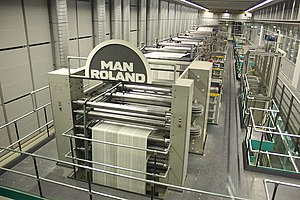
Back الطباعة الملساء غير المباشرة Arabic Офсетов печат Bulgarian অফসেট প্রেস Bengali/Bangla Òfset Catalan Ofset Czech Offsettryk Danish Offsetdruck German Όφσετ Greek Platpreso Esperanto Ófset Spanish



| Part of a series on the |
| History of printing |
|---|
 |
Offset printing is a common printing technique in which the inked image is transferred (or "offset") from a plate to a rubber blanket and then to the printing surface. When used in combination with the lithographic process, which is based on the repulsion of oil and water, the offset technique employs a flat (planographic) image carrier. Ink rollers transfer ink to the image areas of the image carrier, while a water roller applies a water-based film to the non-image areas.
The modern "web" process feeds a large reel of paper through a large press machine in several parts, typically for several meters, which then prints continuously as the paper is fed through.
Development of the offset press came in two versions: in 1875 by Robert Barclay of England for printing on tin and in 1904 by Ira Washington Rubel of the United States for printing on paper.[1] Rubel's contemporary in Continental Europe was Kašpar Hermann, the author of the offset machine prototype (1904), holder of a patent for an offset disc machine (two rubber transfer rollers facing each other) – rolling-press. In 1907, he successfully started printing in Germany on his Triumph sheetfed offset press.[2]
- ^ "offset printing (printing technique)". Encyclopædia Britannica. Retrieved 2013-11-24.
- ^ Stejskalova, Helena (14 November 2016). "Ofsetová tisková technika: Přišla na svět díky zapomnětlivosti?". EpochaPlus. No. Podzim. Retrieved 30 December 2022.